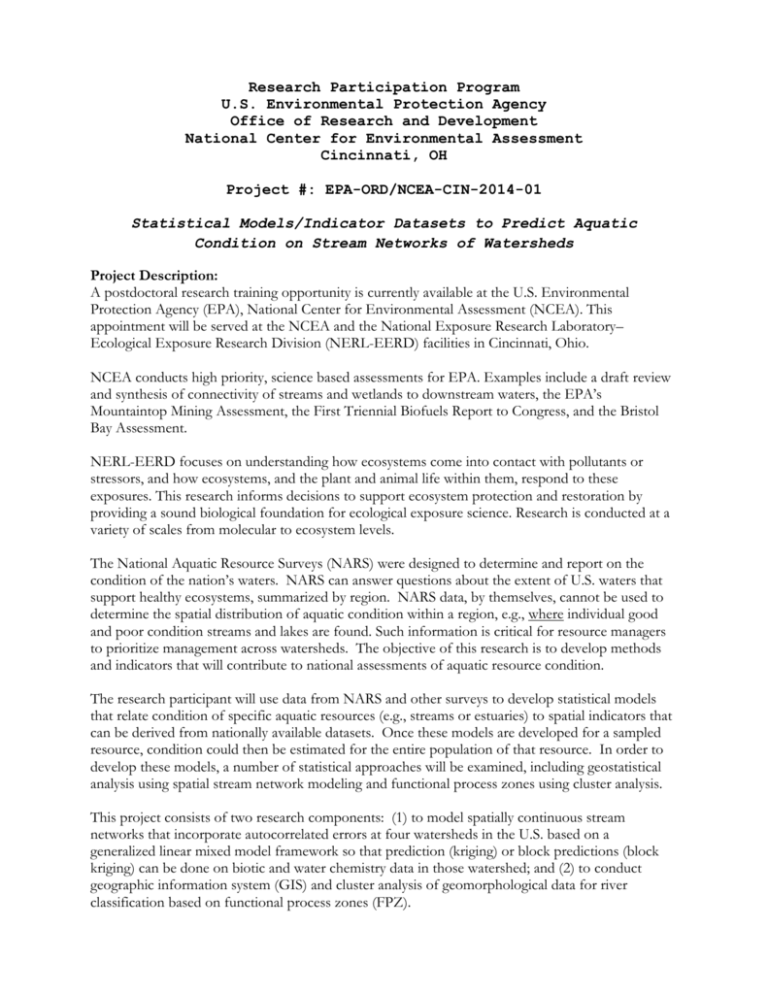Project #: EPA-ORD/NCEA-CIN-2014-01
advertisement

Research Participation Program U.S. Environmental Protection Agency Office of Research and Development National Center for Environmental Assessment Cincinnati, OH Project #: EPA-ORD/NCEA-CIN-2014-01 Statistical Models/Indicator Datasets to Predict Aquatic Condition on Stream Networks of Watersheds Project Description: A postdoctoral research training opportunity is currently available at the U.S. Environmental Protection Agency (EPA), National Center for Environmental Assessment (NCEA). This appointment will be served at the NCEA and the National Exposure Research Laboratory– Ecological Exposure Research Division (NERL-EERD) facilities in Cincinnati, Ohio. NCEA conducts high priority, science based assessments for EPA. Examples include a draft review and synthesis of connectivity of streams and wetlands to downstream waters, the EPA’s Mountaintop Mining Assessment, the First Triennial Biofuels Report to Congress, and the Bristol Bay Assessment. NERL-EERD focuses on understanding how ecosystems come into contact with pollutants or stressors, and how ecosystems, and the plant and animal life within them, respond to these exposures. This research informs decisions to support ecosystem protection and restoration by providing a sound biological foundation for ecological exposure science. Research is conducted at a variety of scales from molecular to ecosystem levels. The National Aquatic Resource Surveys (NARS) were designed to determine and report on the condition of the nation’s waters. NARS can answer questions about the extent of U.S. waters that support healthy ecosystems, summarized by region. NARS data, by themselves, cannot be used to determine the spatial distribution of aquatic condition within a region, e.g., where individual good and poor condition streams and lakes are found. Such information is critical for resource managers to prioritize management across watersheds. The objective of this research is to develop methods and indicators that will contribute to national assessments of aquatic resource condition. The research participant will use data from NARS and other surveys to develop statistical models that relate condition of specific aquatic resources (e.g., streams or estuaries) to spatial indicators that can be derived from nationally available datasets. Once these models are developed for a sampled resource, condition could then be estimated for the entire population of that resource. In order to develop these models, a number of statistical approaches will be examined, including geostatistical analysis using spatial stream network modeling and functional process zones using cluster analysis. This project consists of two research components: (1) to model spatially continuous stream networks that incorporate autocorrelated errors at four watersheds in the U.S. based on a generalized linear mixed model framework so that prediction (kriging) or block predictions (block kriging) can be done on biotic and water chemistry data in those watershed; and (2) to conduct geographic information system (GIS) and cluster analysis of geomorphological data for river classification based on functional process zones (FPZ). The participant may be involved in the following activities: Using geospatial datasets of river and stream networks, geomorphology and land cover GIS data for specific watersheds to develop geodatabases of stream networks Developing spatial statistical models (e.g., spatial stream networks) relating spatial data to independent variables (various indicators of stream condition) to predict condition at the four watersheds Conducting rapid river classification using GIS-delineated functional process zones Applying river classification at regional and national scales Using GIS to develop new spatial indicators Developing similar modeling approach for other aquatic resources (i.e., lakes, estuaries, or wetlands) Conducting geographic data mining, spatial hierarchical modeling, and spatial statistical analysis. The participant will learn about the use of spatial indicators and aquatic monitoring data, and will learn to develop, test, and apply models that relate monitoring data to spatial indicators. S/he will have access to a team of experts collaborating in and across disciplines on problems of crucial importance. S/he will also be encouraged to communicate his/her research results through peerreviewed publications, presentations at meetings of professional societies, and seminars. Qualifications: Applicants must have received a doctoral degree in spatial ecology, geography, spatial statistics, or aquatic ecology within five years of the desired starting, or completion of all requirements for the degree should be expected prior to the starting date. Experience with ArcGIS, Python, and R and the use of monitoring data are highly desirable. The program is open to all qualified individuals without regard to race, sex, religion, color, age, physical or mental disability, national origin, or status as a Vietnam era or disabled veteran. U.S. citizenship or lawful permanent resident status is preferred (but can also hold an appropriate visa status, however, an H1B visa is not appropriate). The appointment is full-time for one year and may be renewed for up to two additional years upon recommendation of NCEA and subject to availability of funds. The participant will receive a monthly stipend. The participant must show proof of health and medical insurance. Funding may be made available to reimburse a research participant's travel expenses to support field studies and to present the results of his/her research at scientific conferences. No funding will be made available to cover travel costs for pre-appointment visits, relocation costs, tuition and fees, or a participant's health insurance. The participant does not become an EPA employee. Technical Contact: The contacts for this project are Michael McManus, NCEA (mcmanus.michael@epa.gov), and Joseph Flotemersch, NERL (flotemersch@joseph.gov). How to Apply: An application can be found at http://orise.orau.gov/epa/applicants/application.htm. Please reference Project #EPA-ORD/NCEA-CIN-2014-01 when calling or writing for information.







